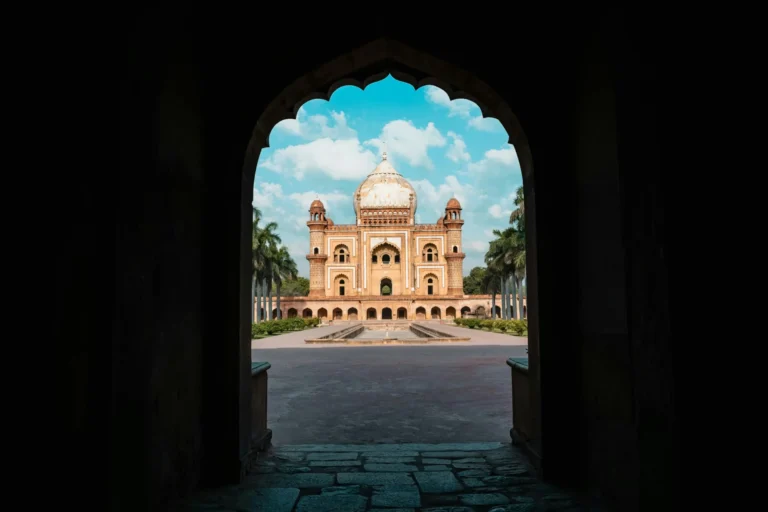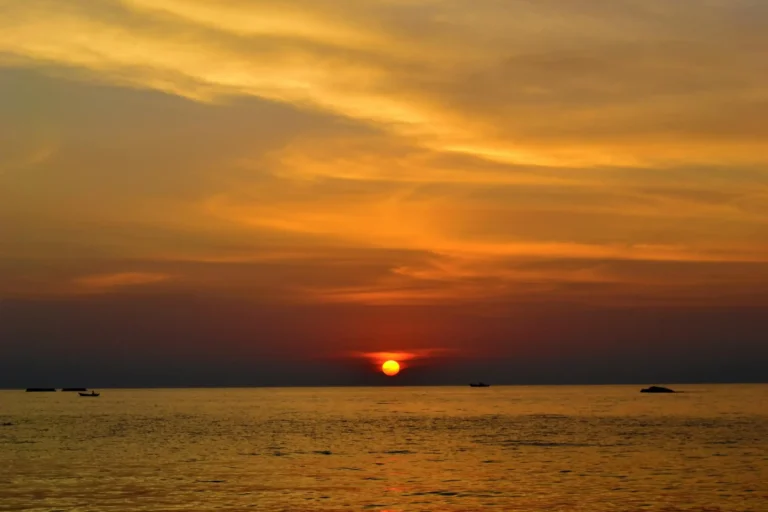Jagannath Temple, Puri, Odisha is one of the most famous temples not only in India but in the whole world. Whenever we think about religious places, particularly temples in India, we are often curious to know about the history behind them. Indian temples have a specific relevance with the glorious history of India. Hindu culture and heritage have come to us for a thousand years and with its progressive message, we must learn to follow its actual message to us. Like Jagannath Temple, several shrines in India teach us the importance of living with purpose and pride. Here we are going to give information about Jagannath temple travel, rituals, festivals, puri temple guide along with some travel tips.
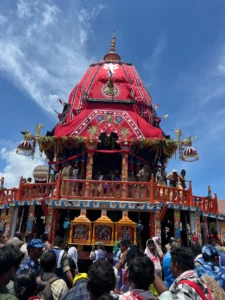
Table of Contents
ToggleThe History and Religious Significance of Jagannath Temple:
India has always been a place where culture and traditions are respected. Every famous temple in India has its own history and characteristics in Indian mythology. Jagannath Temple is no less than that. To know the history of Jagannath Temple, we need to study the kingdom of great kings like King Anantavarman Chodaganga. The temple is dedicated to Lord Jagannath (a form of Vishnu) and has a rich history dating back to the 12th century, the king initiated it and his son Anangabheema Deva III completed it.
Jagannath Temple has a specified process and protocol for following the traditions of the temple. These traditions are followed strictly without any deviation. Many of these temple rituals are based on Oddiyan Tantras. These are taken from Mahayana and Shabari Tantras coming from Tantric Buddhism and tribal beliefs. The temple is also one of the 108 Abhimana Kshretram of the Vaishnavite edition.
The image of Jagannath is made of spruce wood and is replaced every 12 or 19 years with the same replica ceremoniously. During this period the images of all three gods are shifted to another temple as per ritual. For all Hindus, especially from Vaishnav traditions, this temple is very holy and sacred. Great saints like Ramananda, Vallabhacharya, Ramanujacharya, Madhavacharya, and Nimbarkacharya were closely related to this glorious temple.
The seat of one of four shankaracharyas, Govardhan Math was established by Adi Shankakracharya, and Emar Matha, the south-eastern corner of the temple was established by Ramanuja. Chaitanya Mahaprabhu, the founder of Gaudiya Vaishnavism, was also affiliated with the temple and lived for many years in Puri. The Ganga Dynasty and Gajapati Dynasty further developed the temple complex during their subsequent reigns.
As we have seen the three deities Lord Jagannath, Lord Balabhadra, and Devi Subhadra are worshipped in the temple containing its inner sanctum carved from sacred neem logs called ‘daru’ sitting on the platform accompanying deities of Sudarshana Chakra, Madanmohan, Sridevi, and Vishwadhatri. According to the season, the clothes and jewels of the deities are changed, which is also an age-old unbroken tradition.
The most famous festive season of the temple comes with the Ratha Yatra, during which lakhs of pilgrims visit the temple and Puri to pray to Lord Jagannath from across the country, sometimes from outside of the country too.
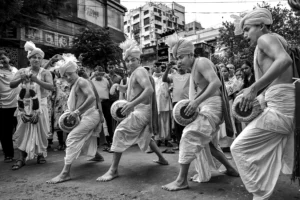
Jagannath Temple Puri Entry time and Rituals Schedule:
| Time (Approx.) | Ritual Name | Details |
| 5:00 AM | Dwara Phita (Door Opening) | Temple doors open. Mangala Aarti is performed. |
| 5:30 AM – 6:00 AM | Mangal Aarti | Early morning aarti to awaken the deities. |
| 6:00 AM – 6:30 AM | Mailam | Previous day’s clothes and flowers removed. |
| 6:30 AM – 7:00 AM | Abakasha | Bathing and brushing teeth of the deities. |
| 7:00 AM – 7:30 AM | Mailam II | New clothes offered. |
| 7:30 AM – 8:00 AM | Sahanamela | Public darshan (free viewing). No rituals during this. |
| 8:00 AM – 8:30 AM | Besha | Deities dressed in new clothes and ornaments. |
| 8:30 AM – 9:00 AM | Rosha Homa, Surya Puja | Fire ritual and Sun worship by temple priests. |
| 9:00 AM – 10:00 AM | Gopala Ballava Bhoga | Light breakfast offered to the deities. |
| 10:00 AM – 10:30 AM | Sakala Dhupa (Morning Bhoga) | Main morning food offering. |
| 11:00 AM – 12:00 PM | Mailam III / Bhoga Mandapa | Bhoga moved to Bhoga Mandap for public offerings. |
| 1:00 PM – 1:30 PM | Madhyanna Dhupa | Midday meal offering to the deities. |
| 1:30 PM – 2:00 PM | Pahuda (Rest Time) | Deities rest. Temple doors remain closed. |
| 4:00 PM – 5:00 PM | Sandhya Dhupa | Evening food offering and rituals. |
| 6:00 PM – 6:30 PM | Sandhya Aarti | Evening aarti and offering of lamps. |
| 8:00 PM – 9:00 PM | Badasinghara Bhoga | Final and most elaborate food offering with music. |
| 9:00 PM – 9:30 PM | Badasinghara Besha | Final dressing of deities for the night. |
| 9:30 PM – 10:00 PM | Pahuda (Final Rest) | Deities put to sleep. Temple doors closed for the night. |
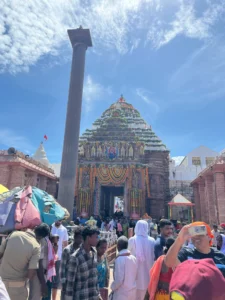
Best Time to Visit Jagannath Temple: Seasonal Guide for Tourists:
The Jagannath Temple is open for pilgrims all year over, and holds specific cultural importance, and traditions that are followed as per rituals. The best time to visit Jagannath Temple is during Ratha Yatra. The best time to visit Jagannath Temple, Puri, Odisha is between October to February because of the amazing atmosphere that gives immense pleasure to tourists. The temperature during this time is around 18.25 degrees Celsius, suitable to explore some other places nearby also.
During monsoon time that falls between June-July in Puri is also a good time to roam around. The most famous festival of Ratha Yatra takes place so pilgrims from all over India visit the temple to get blessings from Lord Jagannath. Those who are interested in architecture, also visit the temple to study the grand and thoughtful architectural wonder. Like Konark Temple, Jagannath Temple is also known for its architectural beauty and scientific views even in those old years.
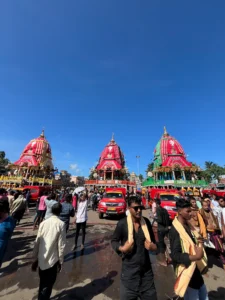
Top Attractions Near Jagannath Temple: Beaches, Lakes, and Heritage Sites:
There are countless attractions near Jagannath Temple, apart from Puri. The tourists who come for God’s blessings have the opportunity to visit beaches, lakes, and heritage sites.
The Odisha Government is taking full efforts to make it a tourist hub as lakhs of tourists visit every year. The beaches at Puri are well developed with various facilities. Administration arranges many events on the beaches on different occasions of festivals. The tourists have the chance to learn the culture and tradition of Odisha.
Beaches in Puri:
There are many beaches in Puri near Jagannath temple to spend some quality time. Some of the best beaches in Puri are Golden Beach, Puri Sea Beach, Swargadwar Sea Beach, Chandrabhaga beach, Pir Jahania and many more. These beaches are heaven for seafood lovers to taste delicious seafood.
Lake in Puri:
Chilika Lake in Puri is the best lake in India. It is popular for saltwater streams. This is because of its geographical position, which is surrounded by the sea. Chilika Lake is famous for sightseeing and dolphin activities. It is also a bird sanctuary where lakhs of migratory birds visit every year.
Heritage Sites in Puri:
Puri, known for its rich heritage, has many heritage sites to visit. Some of the best sites are Konark Temple, which is a UNESCO World Heritage Site, Gundicha Temple, Sakshigopal Temple, Loknath Temple, Alarnath Temple, Pipli, Shri Jagannath Heritage Corridor, Swargadwar Market, and many more.
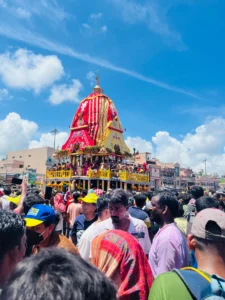
The Jagannath Ratha Yatra Festival: Rituals, Dates, and Visitor Guide:
The Jagannath Ratha Yatra festival in Puri is a well-known festival that is attended by many pilgrims. Every year, lakhs of pilgrims visit to take the blessings of lord Jagannath during the Ratha Yatra festival.
Jagannath Ratha Yatra is one of the oldest and holiest festivals. The festival is celebrated on the bright half of the lunar month of Ashadh which usually falls in June-July month. During this festival, three deities, Lord Jagannath, Lord Balabhadra, and Devi Subhadra are drawn by a huge mass of devotees in three beautifully crafted, huge wooden chariots on ‘bada danda’ to Gundicha Temple. It is a ritual that these three deities reside at Gundicha Temple for a week before their return to Jagannath Temple.
Gundicha Temple is highly decorated to accommodate the three gods for a week. During this week, a proper process to take care of these gods is followed by the Gundicha Temple priest and team. While the chariots are brought to Gundicha Temple, they halt at the crematorium of ‘bhakta Salabega’, a Muslim devotee, to pay him tribute.
On the way back to Jagannath Temple from Gundicha Temple, the chariots halt at Mausi Maa Temple and have an offering of Poda Pitha, a special kind of pancake known as deities favorite. Descriptions of the Ratha Yatra can be found in Skandh Purana, Brahman Purana, Padma Purana, and the Kapila Samhita. The records of the Ratha Yatra are also noted from the 13th century by European travelers. The most prominent and detailed description is found recorded in the 17th century.
The three chariots of the three deities are constructed new every year and the wood used for these is also from specific trees like phassi, Hausa, etc. That is not all because the wood is bought by only specific hereditary carpenters from specific Dasapalla, ex-princely state. The logs are traditionally set afloat in Mahanadi and are collected near Puri, and then transported by road.
The construction of the three chariots is also exclusively done as per the unique description followed over the years. The chariots are decorated on ‘Bada Danda’ (the Grand Avenue). The chariots are then lined up in a wide avenue at the eastern entrance of the temple, which is called Sinhadwar or Lion’s Gate. Nine ‘parsva devatas’ are there along with each chariot. These ‘parsva devatas’ are painted wooden images representing different deities on the chariot’s sides. Each chariot has a sarathi (charioteer) and four horses.
Ratha Yatra is celebrated to commemorate the annual journey of lord Jagannath, Lord Balabhadra, and Devi Subhadra from their temple (home) to their aunt’s temple (home) Gundicha Temple as a symbolic family reunion. The three deities residing at Gundicha Temple for nine days is a symbolic gesture of the family bond between the siblings and relatives. It also suggests that whatever busy you are in, once in a while it must be followed to reunite with your own people and relatives to make the bonds stronger.
It indicates the divine’s accessibility as the deities come out of their sanctums and are among their devotees, meaning that they are available for devotees with their actual appearance. The festival also brings devotees together to give a strong message of unity. As seen in the festival, the three chariots are drawn by the huge mass of devotees who participate in the grand procession and the streets of Puri are full of such devotees. It is believed that King Indradyumna initiated this ritual as per ancient scriptures and legends. The Ratha Yatra held at Puri is the incarnation of Lord Krishna, who is considered to be the most respected god by all devotees.
There are many other festivals in Puri like Chandan Yatra but Ratha Yatra is the biggest. Ratha Yatra has its own messages given to mass which must be understood by Hindu devotees. A simple ritual of deities visiting their aunt’s temple to fulfill the promise is a great learning for all life. Each Hindu festival is celebrated with a purpose and following the rituals in festivals and during actual life is the key to living a peaceful and progressed life.

Where to Stay in Puri: Best Hotels and Accommodation near Jagannath Temple:
There are many hotels, lodges, and budget accommodations available near Jagannath temple. Based on the influx of pilgrims, care is taken to make accommodation affordable to each pilgrim. So the types of accommodation vary from budget to luxury and the visitors can choose the best affordable one for them. Here are some of the preferred hotels in Puri –
Hotel Puri Beach Resort, Chanduka Palace, Hotel VIP Prime, Super Hotel O Jagannatha Temple Paschim Dwar, Shri Lakshmipati Niwas, Hotel Agrawal Pride, Mahadev Ashram, Yellow Hotels, Dev Pratima Premium Residency, Ratan Villa Lodge, Swarn Bhavan, Susila Niwas, Hotel Niladri Complex, Hotel Puri Waves and many more. The rates of the rooms are also affordable and vary between Rs 700 to Rs 3500 approximately depending upon the season.
There are also many dharamshalas and cottages for the poor pilgrims who want to have the blessings of Lord Jagannath.
Conclusion:
Visiting Puri and offering devotion in the Jagannath Temple has been an incredible experience for hundreds of visitors till now. Many have also experienced the peace of mind and tranquility that they were looking for here and have achieved a lot of happiness and satisfaction from their trips.
So, what are you waiting for? Book your tickets, plan your trip, and get ready to explore the heavenly experience of Puri Jagannath Temple now.
- What rules inside the Puri Jagannath Temple?
Visitors are only allowed to enter the temple during the visiting hours and after that, no one is allowed to enter at all. Some etiquette of clothing, behavior, and offerings properly.
- When was the Puri Jagannath Temple built and is it the same since then?
The Puri Jagannath Temple was built in the 12th century. The construction of the temple started in the year 1135 CE and completed in the year 1150 CE. Many modifications and developments have occurred since then and the structure of the temple is immensely changed now.

